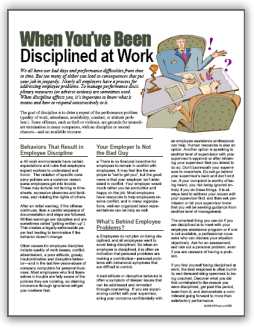 When You've Been Disciplined at Work
When You've Been Disciplined at Work
Click here for New Fact Sheet
for Download but read about it first.
Employers and employees equally dislike the dispensing of discipline, also
referred to as adverse actions. When discipline happens, a variety of employee
reactions are possible.
Some employees accept discipline as a
constructive experience and opportunity for change. Others react to discipline
with anger, resentment, threats, and in the worst cases, violence of the worst
kind.
Discipline isn't going away, no matter what kind of reaction
employees have to it. Some organizations make it the last resort, but
nevertheless, helping employees respond to discipline in a constructive way is a
worthy, possibly life-saving endeavor.
Without a doubt, EAPs are in the
best position to help employees gain the most from a disciplinary experience,
both in heeding its message and gaining the most personal growth from the crisis
it represents.
Whether it's discovering an unresolved personal problem
that contributes to problematic behavior, or reframing discipline as an
opportunity for a better future going forward, managing an employee's reaction
to discipline remains somewhat unexplored territory for stakeholders.
The most rudimentary steps have been recommended by some insurance
companies to prevent violence following disciplinary actions. However, these
ultimate payors of enormous sums resulting from violent reactions to discipline
have not used EAP processes to their fullest advantage.
This is another
argument for EAPs being an essential part of any organization's risk management
strategy. (I'll opine further in my blog.)
This month's editable and
reproducible fact sheet, When You've Been Disciplined at Work, is
designed to add to your ability to help employees respond constructively to the
disciplinary experience. It's part of the new GROUP 5 fact sheets released at EAPtools.com.
Amend this fact sheet with your own experience. Do
collaborate on its use with your HR and management partners. I am certain you
will find creative ways to use it--perhaps before discipline happens--to help
employees, protect organizations, and possibly save lives.
New Fact Sheet for Download